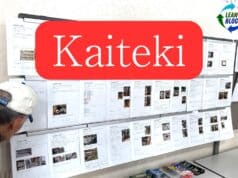By Jason Turgeon:
This is a Lean-meets-EPA powerpoint. Download the original here. Click the little window emblem in the upper-right corner of the embedded image to see it full-screen.
It's been a while since I had the chance to post anything about Lean and Green on this blog, but when an email came across my desk at the EPA yesterday with the powerpoint above attached, I knew I had to stop making excuses for not posting and share it with Lean Blog's readers.
Most of my posts are more abstract, but here's a concrete example of how Lean can be applied to Green. In this case, EPA's Lean effort is directed inward, at our own programs and those we require our state partners to do. In particular, my colleagues in EPA Region 4 as well as in the Iowa state government used Lean to make some dramatic improvements in the process by which they issue permits for the Clean Water Act. These are the permits we issue to sewage treatment plants, power plants, large construction sites, chemical factories, and anyone else who might significantly impact water quality by dumping waste water or contaminating storm water hat goes into a river, stream, or lake.
In most states, the federal government has given the authority to issue these permits to the state environmental department (DEQ, DEP, DES, etc. in the powerpoint). In some states, EPA continues to issue these permits, often in conjunction with the state. The result is that we have 50 different ways to issue what is essentially the same permit. In some places, this permitting process can be especially onerous. One of my first jobs at EPA as an intern was to call dozens of companies that had applied for permits but had never received them to see if they were still in business or still needed the permit. Management was (and still is) trying to resolve a nightmarish permit backlog that left many permitted entities hanging in a kind of legal limbo.
Permits are supposed to be reissued every five years, ideally with stricter and stricter limits so that less and less pollution reaches the water. Companies spend a great deal of time and money applying for permits, and the conditions spelled out in their permits can have an enormous financial impact on these facilities, so we owe them a relatively fast response. But some permits are very complicated, and others involve lots of negotiation between lawyers on both sides. Those permits tend to slow down the easier, less complicated permits. Coupled with layers of bureaucracy and poor systems design, and you have a recipe for general unhappiness.
That's where many permit processes are today. Everyone is frustrated. The permit-writers are unhappy because they want to put out good permits that protect the environment but feel stymied by the bureaucracy and system. Their managers are under great pressure to speed things up, but don't want to put out sloppy permits that allow environmental harm. The facilities that apply for the permits want a resolution quickly so they can get back to work. And the public at large, usually represented by watchdog groups, is often upset because the process is complicated, hard to follow, not always fully transparent, and doesn't always produce the environmental improvements some people advocate for. Sounds like a perfect application for Lean, doesn't it?
At the same time, in another division of the EPA, we have Lean practitioners going out and preaching the gospel of Lean to manufacturing firms because of the waste reduction and commensurate environmental benefits of Lean. Unfortunately, the managers in charge of Lean and the managers in charge of Permits might not even know each other in such a large organization, so we haven't had the full buy-in we need internally to spread the message. In my own office, there are only 2 of us out of about 700 who really know much at all about Lean, and we are working hard to persuade the higher-ups to try it out internally. But getting that kind of buy-in has been difficult. That's why I was so happy to see this powerpoint come by.
Take a look at some of the results from Iowa (slides 20 and 21, with before and after value-stream maps preceding). After the kaizen event and the value-stream mapping were over, one permit process went from 51 steps to 18, from 13 decisions to 5, and from 8 loopbacks to 1. In another permit process, the time it takes to issue a permit dropped from 425 days to just 15. This is a real improvement, with a positive benefit for all of the stakeholders including the environmental groups who represent the planet at large.
There's nothing especially surprising here for experienced Lean practitioners–this is just Lean at work, with all of the usual barriers and successes. But it's Lean being applied to a particular part of the government that has a very big impact on the environment. Let's hope it catches on!
If you have any experiences with the government using Lean to improve processes, please post them in the comments.
Subscribe via RSS | Lean Blog Main Page | Podcast | Twitter @MarkGraban
Please scroll down (or click) to post a comment. Connect with me on LinkedIn.
Let’s work together to build a culture of continuous improvement and psychological safety. If you're a leader looking to create lasting change—not just projects—I help organizations:
- Engage people at all levels in sustainable improvement
- Shift from fear of mistakes to learning from them
- Apply Lean thinking in practical, people-centered ways
Interested in coaching or a keynote talk? Let’s start a conversation.









![When Was the Last Time a Leader Around You Admitted They Were Wrong? [Poll]](https://www.leanblog.org/wp-content/uploads/2025/07/Lean-Blog-Post-Cover-Image-2025-07-01T212509.843-100x75.jpg)
Thanks for these updates Jason, very valuable for us to reflect on and use in our business where sustainability is a main issue and our Operational Excellence (our internal “lean” brand) programme has a need to connect more effectively to this.
By the way can you please confirm the link to download this presentation.
Thanks in advance,
MikeNZ
Hi Mike-
Glad you enjoyed it. Sorry, I’ve fixed the download link in the original post, or use the direct link:
http://www.divshare.com/download/5025273-6da
Jason
At our most recent lean plant tour, I spoke with a a gentleman from EDC (Export Development Canada) where they have implemented lean in one of three divisions.
He said they have had massive improvements and are now able to track the status of work with a whiteboard, and significantly decreased processing time.
[…] Lean and Green at the EPA (Jason Turgeon – Lean Blog): “In another permit process, the time it takes to issue a permit dropped from 425 days to just 15.” […]